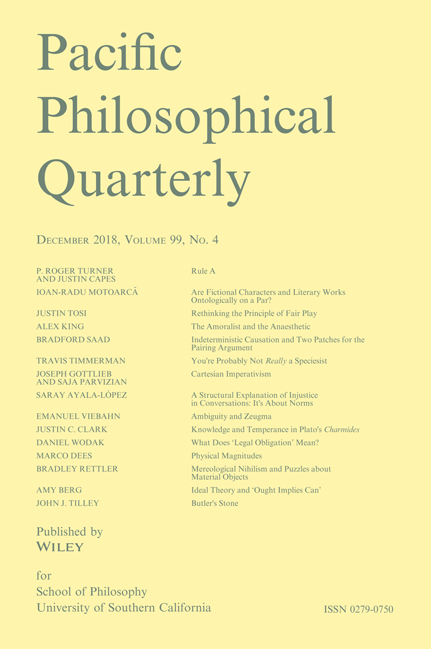Ambiguity and Zeugma
Corresponding Author
Emanuel Viebahn
Department of Philosophy, Humboldt University of Berlin
Churchill College and Faculty of Philosophy, University of Cambridge
Search for more papers by this authorCorresponding Author
Emanuel Viebahn
Department of Philosophy, Humboldt University of Berlin
Churchill College and Faculty of Philosophy, University of Cambridge
Search for more papers by this authorAbstract
In arguing against a supposed ambiguity, philosophers often rely on the zeugma test. In an application of the zeugma test, a supposedly ambiguous expression is placed in a sentence in which several of its supposed meanings are forced together. If the resulting sentence sounds zeugmatic, that is taken as evidence for ambiguity; if it does not sound zeugmatic, that is taken as evidence against ambiguity. The aim of this article is to show that arguments based on the second direction of the test are misguided: ambiguous expressions, and in particular philosophically contested ones, do not reliably lead to zeugmaticity, so an absence of zeugmaticity provides no meaningful evidence for an absence of ambiguity.
References
- Abbott, B. (2013). ‘Linguistic Solutions to Philosophical Problems: The Case of Knowing How,’ Philosophical Perspectives 27, pp. 1–21.
- Amaral, F. S. (2008). ‘Definite Descriptions are Ambiguous,’ Analysis 68, pp. 288–297.
- Bach, K. (2004). ‘ Descriptions: Points of Reference,’ in M. Reimer and A. Bezuidenhout (eds) Definite Descriptions and Beyond. Oxford: Clarendon Press, pp. 189–229.
10.1093/oso/9780199270514.003.0005 Google Scholar
- Bengson, J. and Moffett, M. A. (2007). ‘Know-how and Concept Possession,’ Philosophical Studies 136, pp. 31–57.
- Carr, D. (1981). ‘Knowledge in Practice,’ American Philosophical Quarterly 18, pp. 53–61.
- Chomsky, N. (2000). New Horizons in the Study of Language and Mind. Cambridge: Cambridge University Press.
10.1017/CBO9780511811937 Google Scholar
- Cruse, D. (2011). Meaning in Language: An Introduction to Semantics and Pragmatics. Oxford: Oxford University Press.
- Devitt, M. (1981). ‘ Donnellan's Distinction,’ in P. A. French, T. E. Uehling and H. K. Wettstein (eds) Midwest Studies in Philosophy, Volume VI: The Foundations of Analytic Philosophy. Minneapolis, MN: University of Minnesota Press, pp. 511–524.
10.1111/j.1475-4975.1981.tb00456.x Google Scholar
- Falkum, I. L. and Vicente, A. (2015). ‘Polysemy: Current Perspectives and Approaches,’ Lingua 157, pp. 1–16.
- Gill, M. (2008). ‘ Meta-ethical Variability, Incoherence, and Error,’ in W. Sinnott-Armstrong (ed.) Moral Psychology, Vol. 2: The Cognitive Science of Morality. Cambridge, MA: MIT Press, pp. 387–401.
- Gillon, B. (2004). ‘ Ambiguity, Indeterminacy, Deixis, and Vagueness: Evidence and Theory,’ in S. Davis and B. Gillon (eds) Semantics: A Reader. Oxford: Oxford University Press, pp. 157–187.
- Grzankowski, A. (2016). ‘Attitudes Towards Objects,’ Noûs 50, pp. 314–328.
- Hawthorne, J. and Lepore, E. (2011). ‘On Words,’ The Journal of Philosophy 108, pp. 447–485.
- Koralus, P. (2013). ‘Descriptions, Ambiguity, and Representationalist Theories of Interpretation,’ Philosophical Studies 162, pp. 275–290.
- Kremer, M. (2017). ‘A Capacity to Get Things Right: Gilbert Ryle on Knowledge,’ European Journal of Philosophy 25, pp. 25–46.
- Kripke, S. (1977). ‘Speaker's Reference and Semantic Reference,’ Midwest Studies in Philosophy 2, pp. 255–276.
10.1111/j.1475-4975.1977.tb00045.x Google Scholar
- Lakoff, G. (1970). ‘A Note on Vagueness and Ambiguity,’ Linguistic Inquiry 1, pp. 357–359.
- Löwenstein, D. (2017). The Concept of Competence. A Rylean Responsibilist Account of Know-how. Frankfurt a. M.: Vittorio Klostermann.
- Lyons, J. (1977). Semantics. Cambridge: Cambridge University Press.
10.1017/CBO9780511620614 Google Scholar
- Nunberg, G. (1979). ‘The Non-Uniqueness of Semantic Solutions: Polysemy,’ Linguistics & Philosophy 3, pp. 143–184.
- Oliver, A. and Smiley, T. (2001). ‘Strategies for a Logic of Plurals,’ The Philosophical Quarterly 51, pp. 289–306.
- Pickel, B. (2010). ‘There Is No “Is” of Constitution,’ Philosophical Studies 147, pp. 193–211.
- Rumfitt, I. (2003). ‘Savoir Faire,’ Journal of Philosophy 100, pp. 158–166.
- Ryle, G. (1949). The Concept of Mind. London: Hutchinson and Co.
- Sennet, A. (2002). ‘An Ambiguity Test for Definite Descriptions,’ Philosophical Studies 111, pp. 81–95.
- Sennet, A. (2016). ‘ Polysemy,’ in S. Goldberg (ed): Oxford Handbooks Online: Philosophy.URL = < http://www.oxfordhandbooks.com/view/10.1093/oxfordhb/9780199935314.001.0001/oxfordhb-9780199935314-e-32>.
10.1093/oxfordhb/9780199935314.013.32 Google Scholar
- Sinnott-Armstrong, W. (2009). ‘Mixed-up Meta-ethics,’ Philosophical Issues 19, pp. 235–256.
10.1111/j.1533-6077.2009.00168.x Google Scholar
- Stanley, J. (1998). ‘Persons and their Properties,’ The Philosophical Quarterly 48, pp. 159–175.
- Stanley, J. (2005). ‘Hornsby on the Phenomenology of Speech,’ in: J. Hornsby and J. Stanley: ‘Semantic Knowledge and Practical Knowledge,’ Proceedings of the Aristotelian Society 2005, pp. 107–145.
- Stanley, J. (2011). ‘Knowing (How),’ Noûs 45, pp. 207–238.
- Stanley, J. and Williamson, T. (2001). ‘Knowing How,’ Journal of Philosophy 98, pp. 411–444.
- Sweetser, E. (1990). From Etymology to Pragmatics: Metaphorical and Cultural Aspects of Semantic Structure. Cambridge: Cambridge University Press.
10.1017/CBO9780511620904 Google Scholar
- Traugott, E. (1989). ‘On the Rise of Epistemic Meanings in English: An Example of Subjectification in Semantic Change,’ Language 65, pp. 31–55.
- Viebahn, E. and Vetter, B. (2016). ‘How Many Meanings for “May”? The Case for Modal Polysemy,’ Philosophers’ Imprint 16(10), pp. 1–26.
- Wiggins, D. (2004). Sameness and Substance Renewed. Cambridge: Cambridge University Press.
- Zwicky, A. M. and Sadock, J. M. (1975). ‘Ambiguity Tests and How to Fail Them,’ Syntax and Semantics 4, pp. 1–36.




